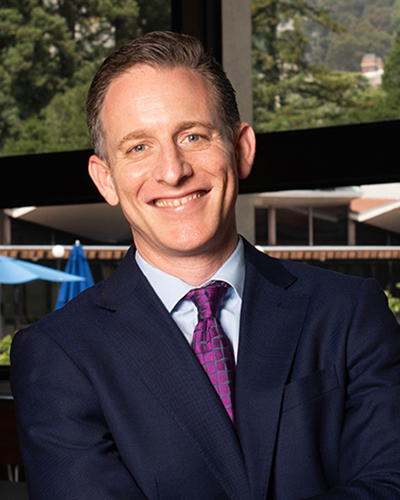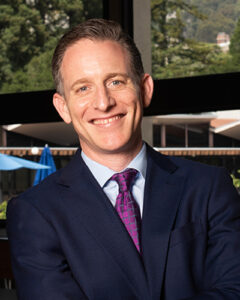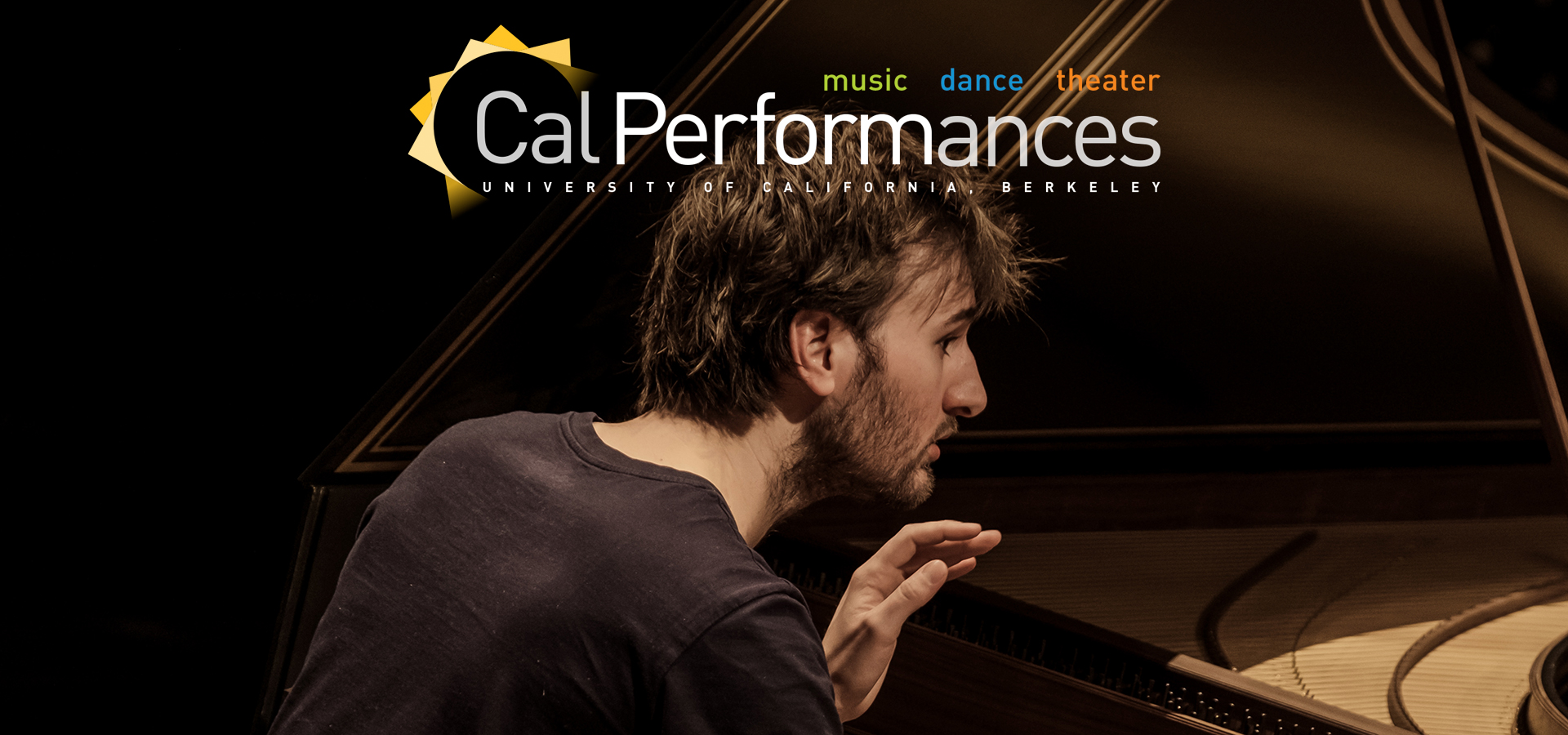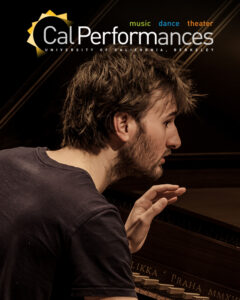Jean Rondeau, harpsichord
Gradus ad Parnassum
Sunday, November 5, 2023, 3pm
Hertz Hall
This program will be performed without intermission and last approximately 70 minutes.
From the Executive and Artistic Director

November is always a busy month at Cal Performances, and once again this season, I can’t think of a time period that so clearly displays the impressive depth and breadth of our programming. In the coming weeks alone, we’ll run the gamut of live performance, including classical-music recitals with star instrumentalists cellist Sheku Kanneh-Mason (Nov 1) and harpsichordist Jean Rondeau (Nov 5); the brilliant ensemble playing of early-music champions Le Consort (Nov 8) and the Takács Quartet (Nov 12); a return visit by the great San Francisco Symphony, performing under Music Director Esa-Pekka Salonen in a concert featuring the world premiere of a new work by Jens Ibsen and a solo turn by the orchestra’s principal clarinetist Carey Bell (Nov 10); a brilliant new program by the always popular Silkroad Ensemble under artistic director Rhiannon Giddens (Nov 17); our annual visit by The English Concert in an all-star concert performance of Handel’s Rodelina (Nov 19); cutting-edge jazz from the legendary trio of pianist Brad Mehldau (Nov 11); and highly anticipated appearances by theater/cabaret sensations John Cameron Mitchell and Amber Martin (Nov 4) and Broadway superstar Kristin Chenoweth (Nov 15).
And that’s only the start! As we continue through the season, you’ll find more than 80 carefully curated events designed to appeal to the eclectic interests and adventurous sensibilities of Bay Area audiences. In total, this year’s schedule features nearly 30 companies, ensembles, and solo artists new to our program, offering a wide range of opportunities to discover unfamiliar performers and artworks. There’s plenty to enjoy, including six world premieres, six Cal Performances co-commissions, nearly one dozen local and regional premieres, and the West Coast premieres of Taylor Mac & Matt Ray’s Bark of Millions and Nathalie Joachim’s Ki moun ou ye (Who are you?).
Cal Performances continues to invest in ongoing relationships with established and acclaimed artistic partners, with upcoming presentations including a landmark collaboration between Germany’s Pina Bausch Foundation, Senegal’s École des Sables, and the UK’s Sadler’s Wells theater in the first-ever Bay Area performances of Bausch’s pioneering The Rite of Spring (1975), as well as the renewal of a multi-season residency by The Joffrey Ballet, which this year will present its first full-length narrative ballet, Anna Karenina, at Zellerbach Hall. And I’m especially pleased that in March 2024, the renowned pianist Mitsuko Uchida will join us as Artist in Residence for two special concerts as well as additional opportunities for the campus and wider Bay Area community to engage with her singular artistry.
A focus of the season will be our multi-dimensional Illuminations programming, which once again will connect the work of world-class artists to the intellectual life and scholarship at UC Berkeley via performances and public programs investigating a pressing theme—this season, “Individual & Community.” Concepts of “individual” and “community” have been at the forefront of public discourse in recent years, with some models increasing polarization and radicalization within our society. Questions have emerged as to how we can best nurture a sense of community and how the groups we associate with impact our own sense of self. Given our fast-evolving social landscape, how can we retain and celebrate the traits that make each of us unique, while still thriving in a world that demands cooperation and collaboration? With the performing arts serving as our guide and compass, our 2023–24 “Individual & Community” programming will explore the tensions that come into play when balancing the interests of the individual with those of the group.
Please make sure to check out our website for complete information. We’re thrilled to share all the details with you, and to welcome you once again to Cal Performances!
Jeremy Geffen
Executive and Artistic Director, Cal Performances
 November is always a busy month at Cal Performances, and once again this season, I can’t think of a time period that so clearly displays the impressive depth and breadth of our programming. In the coming weeks alone, we’ll run the gamut of live performance, including classical-music recitals with star instrumentalists cellist Sheku Kanneh-Mason (Nov 1) and harpsichordist Jean Rondeau (Nov 5); the brilliant ensemble playing of early-music champions Le Consort (Nov 8) and the Takács Quartet (Nov 12); a return visit by the great San Francisco Symphony, performing under Music Director Esa-Pekka Salonen in a concert featuring the world premiere of a new work by Jens Ibsen and a solo turn by the orchestra’s principal clarinetist Carey Bell (Nov 10); a brilliant new program by the always popular Silkroad Ensemble under artistic director Rhiannon Giddens (Nov 17); our annual visit by The English Concert in an all-star concert performance of Handel’s Rodelina (Nov 19); cutting-edge jazz from the legendary trio of pianist Brad Mehldau (Nov 11); and highly anticipated appearances by theater/cabaret sensations John Cameron Mitchell and Amber Martin (Nov 4) and Broadway superstar Kristin Chenoweth (Nov 15).
November is always a busy month at Cal Performances, and once again this season, I can’t think of a time period that so clearly displays the impressive depth and breadth of our programming. In the coming weeks alone, we’ll run the gamut of live performance, including classical-music recitals with star instrumentalists cellist Sheku Kanneh-Mason (Nov 1) and harpsichordist Jean Rondeau (Nov 5); the brilliant ensemble playing of early-music champions Le Consort (Nov 8) and the Takács Quartet (Nov 12); a return visit by the great San Francisco Symphony, performing under Music Director Esa-Pekka Salonen in a concert featuring the world premiere of a new work by Jens Ibsen and a solo turn by the orchestra’s principal clarinetist Carey Bell (Nov 10); a brilliant new program by the always popular Silkroad Ensemble under artistic director Rhiannon Giddens (Nov 17); our annual visit by The English Concert in an all-star concert performance of Handel’s Rodelina (Nov 19); cutting-edge jazz from the legendary trio of pianist Brad Mehldau (Nov 11); and highly anticipated appearances by theater/cabaret sensations John Cameron Mitchell and Amber Martin (Nov 4) and Broadway superstar Kristin Chenoweth (Nov 15).
And that’s only the start! As we continue through the season, you’ll find more than 80 carefully curated events designed to appeal to the eclectic interests and adventurous sensibilities of Bay Area audiences. In total, this year’s schedule features nearly 30 companies, ensembles, and solo artists new to our program, offering a wide range of opportunities to discover unfamiliar performers and artworks. There’s plenty to enjoy, including six world premieres, six Cal Performances co-commissions, nearly one dozen local and regional premieres, and the West Coast premieres of Taylor Mac & Matt Ray’s Bark of Millions and Nathalie Joachim’s Ki moun ou ye (Who are you?).
Cal Performances continues to invest in ongoing relationships with established and acclaimed artistic partners, with upcoming presentations including a landmark collaboration between Germany’s Pina Bausch Foundation, Senegal’s École des Sables, and the UK’s Sadler’s Wells theater in the first-ever Bay Area performances of Bausch’s pioneering The Rite of Spring (1975), as well as the renewal of a multi-season residency by The Joffrey Ballet, which this year will present its first full-length narrative ballet, Anna Karenina, at Zellerbach Hall. And I’m especially pleased that in March 2024, the renowned pianist Mitsuko Uchida will join us as Artist in Residence for two special concerts as well as additional opportunities for the campus and wider Bay Area community to engage with her singular artistry.
A focus of the season will be our multi-dimensional Illuminations programming, which once again will connect the work of world-class artists to the intellectual life and scholarship at UC Berkeley via performances and public programs investigating a pressing theme—this season, “Individual & Community.” Concepts of “individual” and “community” have been at the forefront of public discourse in recent years, with some models increasing polarization and radicalization within our society. Questions have emerged as to how we can best nurture a sense of community and how the groups we associate with impact our own sense of self. Given our fast-evolving social landscape, how can we retain and celebrate the traits that make each of us unique, while still thriving in a world that demands cooperation and collaboration? With the performing arts serving as our guide and compass, our 2023–24 “Individual & Community” programming will explore the tensions that come into play when balancing the interests of the individual with those of the group.
Please make sure to check out our website for complete information. We’re thrilled to share all the details with you, and to welcome you once again to Cal Performances!
Jeremy Geffen
Executive and Artistic Director, Cal Performances
About the Program
Climbing the Mountain
“I come to you, venerable master, in order to be introduced to the rules and principles of music.” So begins Gradus ad Parnassum (in the standard translation by Alfred Mann), a theoretical overview of and guide to the art of counterpoint that Johann Joseph Fux (1660–1741) published in 1725, at the apex of his long career. Grove Online deems it “the most influential composition treatise in European music from the 18th century onwards.”
The Latin title means “Steps to Parnassus” and refers to a long tradition of instructional reference books intended to guide eager students along the path to gradual acquisition of the practical knowledge necessary to succeed in a particular field, such as learning a language or how to play an instrument—or, in Fux’s case, how to compose using the tools of counterpoint (among other topics).
The image of Parnassus anchors such endeavors in the ancient classical tradition: Mount Parnassus was sacred to Apollo as well as one of the locations favored by the Muses. Fux further staked his claim as part of this pedagogical pedigree by publishing his text in Latin (though the ancient language was fast nearing the end of its hegemony as a European lingua franca). Gradus ad Parnassum belonged to J.S. Bach’s library and was used by Haydn, Mozart, and Beethoven, among countless other figures. “Perhaps the craft of composition would really have fallen into decline if Fux’s Gradus had not set up a standard,” remarked Paul Hindemith.
Jean Rondeau brings a contemporary twist to this tradition by arriving at the very 21st-century conclusion that “it’s the narrative that drives musical knowledge”—as he puts it in the essay accompanying his album Gradus ad Parnassum (released this past spring), from which this recital program is drawn. Cleverly emulating the Socratic dialogue format used by Fux, Rondeau in his album commentary has his alter ego, the student, explain what attracted him to the famous treatise: “Represented there are themes that are dear to me: practice, constraint, the Gradus (the ascent, yes, but also its inverse, the starting over of Sisyphus, his descent), and the architectural concepts that stem from it….”
The young French harpsichordist makes the case for his instrument not from an “early music” perspective of historically informed practice but as an experimenter intrigued by its unacknowledged expressive potential. In the process, Rondeau encourages us to reexamine longstanding assumptions about these canonical composers—and to be open to hearing them in a new context. For the music itself, as his imaginary Parnassian teacher affirms, “never leaves us disenchanted.”
Although best known to posterity for his treatise on how to write music, Johann Joseph Fux was himself a prodigiously productive composer. He served as Hofkapellmeister to a series of Habsburg emperors in the early 18th century, synthesizing the Austrian and Italian components of Viennese late Baroque style through a vast output of sacred music, opera, and instrumental works.
Harpeggio, composed by around 1730 at the latest and the sole work on Rondeau’s program that was apparently written for harpsichord, wriggles free of any hint of doctrinaire rule-making. It is actually the first of three movements that appear side-by-side in Fux’s manuscript, where it introduces a fugue in the same key of G major. But in the context of this recital, the piece’s toccata-style fantasizing functions as a spirited curtain raiser to an array of composers and styles normally associated with the piano. Characteristic of Rondeau’s thoughtful and subtle interventions is the omission of four bars of arpeggiated vamping chords in Fux’s score, so that he begins with a scalar “staircase” that vividly encapsulates the image of an ascent.
Fux himself anchored his teaching in a reverence for the wisdom of the past, represented principally by the example of Palestrina. The dramaturgy underlying the program Rondeau has curated involves cross-connections (and also rivalries) between teachers and students who speak to one another across the centuries. Joseph Haydn (1732–1809) made up for his lack of formal training in theory and composition by studying the Gradus ad Parnassum. The Sonata in A-flat major, Hob. XVI:46, displays the confident originality Haydn was cultivating during his years of isolation from the Viennese epicenter at the Esterházy court.
Although he did not develop a dual career as a solo celebrity performer—in contrast to Mozart and Beethoven, who initially established their reputations in Vienna as keyboard virtuosos—Haydn composed at the keyboard, and his catalogue includes a significant number of solo sonatas.
Dating from the late 1760s but not published until 1788, the Sonata in A-flat major—Haydn in fact called it a “divertimento,” continuing to use older-fashioned terms at this stage—betrays the influence of another formative teacher as well. “Whoever knows me thoroughly must discover that I owe a great deal to [Carl Philipp] Emanuel Bach, that I understood him and studied him with diligence,” as Haydn told his early biographer. C.P.E. Bach’s aesthetic of intensified expression through powerful juxtapositions, labeled empfindsamer Stil (“sensitive style”)—a musical parallel to the revolutionary insights of Jean-Jacques Rousseau—became associated with the quest for emotional authenticity.
The A-flat major Sonata reflects this sensibility in manifold ways, beginning with the gracefully ornamented and meditative opening theme of the widely ranging first movement. Rondeau’s harpsichord interpretation highlights shifts in color between registers and tonalities as well as quasi-improvisatory disruptions and embarkations. An especially affecting Adagio (in D-flat major, an unusual key choice for the time) retreats inward in wonderfully unpredictable ways, while the wit expected of a Haydn finale propels a highly condensed argument, culminating in a dazzling architecture of rising and falling scales.
Muzio Clementi (1752–1832), a determinative influence on the development of the modern piano, began his career as a harpsichord virtuoso and later became an influential piano manufacturer and publisher who disseminated some of Beethoven’s works. He published his own Gradus ad Parnassum, Op. 44, comprising 100 pieces in three volumes (the last appearing in 1826). A summa of his technical knowledge as a composer and pianist, Clementi’s Gradus conveys a “lifelong fascination with ‘learned’ procedures,” according to Leon Plantinga. Some of the pieces have programmatically suggestive titles, such as the “Preludio Andante malinconico” in C minor (No. 45), which, like Fux’s Harpeggio, Rondeau plays as a self-standing piece, omitting the fugue to which it was originally attached.
As a teacher, Haydn had a famously fraught relationship with the young Ludwig van Beethoven (1770–1827), but his recommendation to study Fux was taken up: we know that Beethoven owned the German translation of Gradus ad Parnassum and made notes from it to teach composition to his own pupil, Archduke Rudolph. But Beethoven began his ascent to Parnassus through close study of the Well-Tempered Clavier during his youth in Bonn. A little-known pair of preludes, the Op. 39 set in C major, also shows his fascination with Bach at this stage and may have been written for organ. (Young Ludwig was court organist at the time.)
Op. 39 dates from 1789 and was written at the end of Beethoven’s teenage years, before his move to Vienna. (The relatively high opus number reflects the later publication of these preludes in 1803.) Beethoven emulates Bach’s systematic approach to tonality in the Well-Tempered Clavier but compacts it radically by traversing all 24 major and minor keys within a few minutes in each prelude. The Prelude No. 2 in C major is even more condensed than its sibling, moving restlessly from key to key.
Wolfgang Amadeus Mozart (1756–91) likely came under the influence of Fux’s Gradus ad Parnassum at an early age: his father Leopold, also a teacher, owned a copy and tried to inculcate his own musical values even in his adult son. In any event, in his mature Vienna years he adapted excerpts from Fux for composition lessons he gave to the Englishman Thomas Attwood in 1785–87.
But the approach to Parnassus entails not only patient discipline but the burning ambition that fuels rivalry. Clementi and Mozart engaged in a famous keyboard duel in Vienna in 1781, instigated by Emperor Joseph II, which resulted in a draw, with the prize money split between the two—though Clementi could be said to have emerged the winner insofar as he was open to learning from his admiration of Mozart’s uniqueness. “Until then I had never heard anyone play with so much spirit and grace,” he later recalled.
For Mozart, as for Beethoven, the piano was his alter ego, the key to his celebrity as a virtuoso when he settled in Vienna. It served both as a means to make a living and as a vehicle for compositional experimentation. Hearing these works on the harpsichord—at least as interpreted by Jean Rondeau—jolts them just enough out of the familiar to evoke a hint of Mozart’s search for the perfect balance of means and ends, of form and emotion. The private, domestic sphere of the solo sonata became the receptacle for some of his finest inspirations—even when the apparent purpose was to teach his piano students, as with the C major Sonata from June 1788 (K. 545), intended “for beginners,” as Mozart himself notated in his personal thematic catalogue.
Scales, so metaphorically apt for the Parnassian journey but also a necessary practical building block, figure prominently in the opening Allegro. Yet, as any student of Mozart comes to know, to elicit such deceptively effortless, Arcadian grace from the keyboard with authentic musical feeling requires remarkable resources. This is perhaps even more so when it comes to making the melody of the Andante “sing” with its full potential. Humor turns out to be indispensable as well for a fully rounded education, as the rondo finale shows by playing with a sophisticated awareness of the most basic issues of coordination.
As Rondeau’s alter ego puts it: “[Mozart’s] music is so nurturing. It makes us learn how to walk and how to laugh all over again. The adult in us vanishes… all our hang-ups disappear. I don’t know why, but when I hear his music, I feel like it had been there all along, somewhere. He just grabbed it.”
The Rondo in A minor (K. 511) from 1787 transforms a simple ornamental turn—stock in trade for Baroque and Classical composers, normally a passing bit of polish—into a matter of substance, fretted over like worry beads, while the assurance of the elementary scale is undercut by its chromatic inflections.
There is a curious history behind the Fantasia No. 3 in D minor (K. 397). It originated early in Mozart’s Vienna decade, in 1782, but was left incomplete; an anonymous admirer wrote the final 10 measures of the version that was published after the manuscript was posthumously discovered. At its heart, in the central Adagio section introduced by weighty arpeggiations, is an instrumental aria whose pathos is enhanced by the harpsichord’s resonant colors. The turn to D major in the final Allegretto section feels more like a dream of past joy suddenly recalled than a resolution of the preceding grief.
—© 2023 by Thomas May




